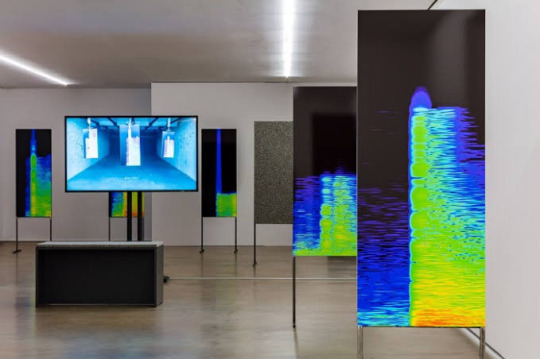#Lawrence Abu Hamdan
Text
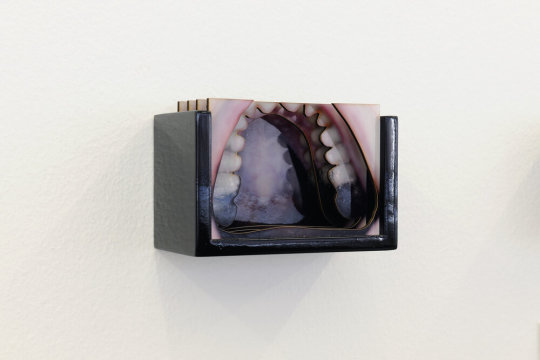
Lawrence Abu Hamdan LA_Disputed Utterance, 2019
83 notes
·
View notes
Text
Shibboleth
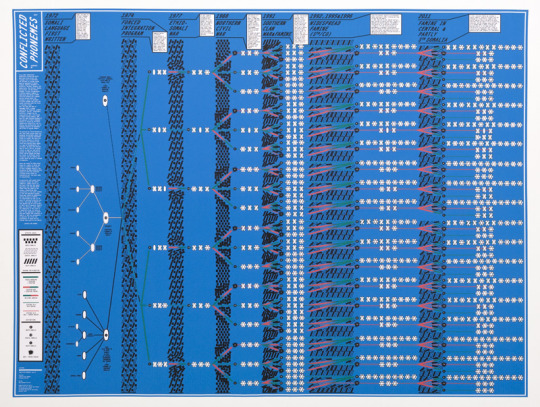
Conflicted Phonemes, 2012, Lawrence Abu Hamdan with graphic designer Janna Ullrich.
Lawrence Abu Hamdan is an independent investigator or Private Ear with a great interest in the political use of sound and linguistics.
Conflicted Phonemes is made of vinyl wall prints and takeaway printed A4 sheets on a shelf. The prints visualize the complex relation between a person’s place of birth and linguistic identity, whilst also examining how itinerant and precarious social conditions and cultural exchange result in a hybridization of accents, thus questioning the efficacy of forensic technologies and practices of “bordering” conducted by Dutch immigration authorities.
I wish I could experience this work and the follow-up, also from 2012, The Freedom of Speech focusing on the UK’s controversial use of voice analysis to determine the origins and authenticity of asylum seekers’ accents.
The Freedom of Speech is a mixed-media installation comprising a stereo audio documentary and an acoustic foam sculpture on the geopolitics of accents and listening practices that have led to shocking stories of wrongful deportations.
Judges 12:5-6 English Standard Version:
they said to him, “Then say Shibboleth,” and he said, “Sibboleth,” for he could not pronounce it right. Then they seized him and slaughtered him at the fords of the Jordan. At that time 42,000 of the Ephraimites fell.
There are lots of articles on Abu Hamdan’s work. Here just one written by Emily Apter : Shibboleth: Policing by Ear and Forensic Listening in Projects by Lawrence Abu Hamdan, 2016 October Magazine, Ltd. and Massachusetts Institute of Technology, https://doi.org/10.1162/OCTO_a_00253
Abstract: Drawing on the work of Lawrence Abu Hamdan, a British-Lebanese artist and researcher currently based in Beirut, this essay examines the juridical and conceptual field of critical forensis which is situated at the juncture of security studies, art, and architecture. Abu Hamdan extends forensics to the area of “new audibilities,” with a focus on the politics of juridical hearing in situations of legal-identity profiling and voice authentication (the “shibboleth test”). Abu Hamdan's projects investigate how accent monitoring and audio surveillance, voice recognition, translation technologies, sovereign acts of listening, and court determinations of linguistic norms emerge as so many technical constraints on “freedom of speech,” itself a malleable term ascribed to discrepant claims and principles, yet taking on performative force in site-specific situations.
#Lawrence Abu Hamdan#new audibilities#Shibboleth#voice analysis#bordering#forensic technologies#art#policing#immigration
3 notes
·
View notes
Photo
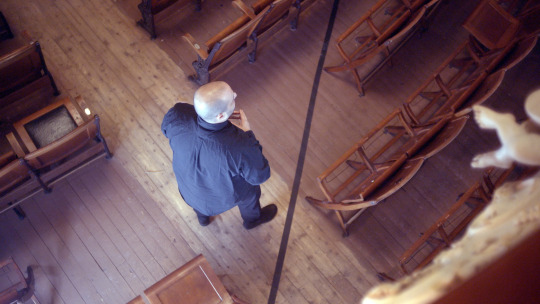
45th Parallel, Lawrence Abu Hamdan (2022)
0 notes
Text
Some cool print, print-based, print informed, and print adjacent things at ICA @ VCU's newest exhibition "So it appears".

I recently got the chance to check out VCU's ICA newest exhibition So it appears, a survey of abstract works addressing how visual strategies of abstraction can be tools used for political and aesthetic change. Here's a list of some print-like, print based, print- adjacent works that were really cool to see.
-
Agnieszka Kurant's lenticular prints.



Kurant's lenticular print shows a visual shift between a series of images. Kurant's work explores the how social intention and aura of economies and cultural production can be explored through unconventional materials and methods. This work is truly captivating and puzzling.
-
Monira Al Qadiri's levitating 3D objects.
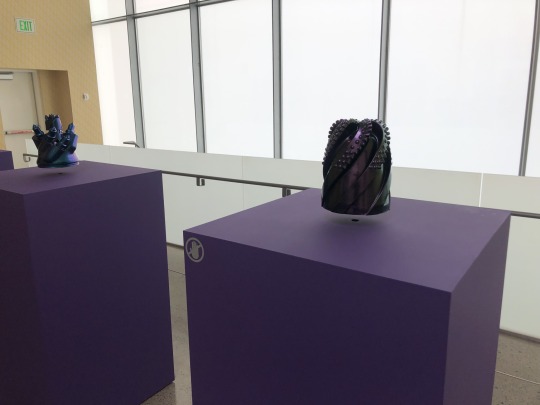
Al Qadiri's cast and levitated iridescent objects at close glance showcase the slick and sensible color and material quality that these sculptural forms embody. Upon further investigation you realize that these shapes are inspired by oil drills - making a visual connection between the object and the mystery of production of oil companies.
-
Lawrence Abu Hamden's large inket prints mounted to dibond.

This print is absolutely massive at 2155 inches long, it's scale tying deeply to the meaning of the work.
Quoting the artists website, "Linking the ocular and the auditory, Air Conditioning distills Abu Hamdan’s concept of the ‘sonic image’ through a textured visual rendering of what he has dubbed, ‘atmospheric violence’." I see Abu Hamden's work as a map/record, and their attempt to visualize "Israeli army‘s sonic occupation of the Lebanese airspace" is profoundly successful.
3 notes
·
View notes
Quote
Focusing on the Haskell Free Library and Opera House – a unique municipal site that straddles the jurisdictions of Canada and the United States – the work continually recasts the border as at once powerful yet facile, absurd yet lethal.
Originally built in 1904, the Haskell building was designed as a symbol of unity between Canada and the US and is one of the only cross-border theatres in the world. Anyone can enter unchecked and, though a thick black line runs through the entire building, once inside the border all but disappears.
Filmed on location to activate the legal and symbolic potential of the site, 45th Parallel unfolds as a monologue in five acts, performed by acclaimed filmmaker Mahdi Fleifel. The story centres on Hernández vs. Mesa, a judicial case covering the fatal shooting in 2010 of an unarmed fifteen-year-old Mexican national by a US Border Patrol agent. At the supreme court Mesa’s bullet, which crossed the US/Mexico border, began to implicate missiles fired in Yemen, Syria, Afghanistan, Pakistan, Iraq, Somalia and Libya. If this murder could be tried in the US, so too could 91,340 drone strikes.
45th Parallel — Lawrence Abu Hamdan
0 notes
Text
0 notes
Text
Blog 9 – Evidentiary Realism and Investigative Aesthetics
“Evidentiary Realism” by Paolo Cirio
In this piece, artist Paolo Cirio outlines the return of realism, specifically of “Evidentiary Realism.” Realism has returned to art recently through the clash and cooperation of investigative practices, forensic documentaries, and artistic aesthetics. Realist art has always been a powerful tool to denounce the dirt conceived under societies, and now it has a new aesthetic, updated to our modern times.
According to the author, reality is now out of sight. It is so complex nowadays that it is not easily tangible. Even if we can see the consequences of our reality sometimes because of its complexity and multidisciplinary structural nature we fail to see its agents and originating systems. Nowadays the real is so interconnected with the power structures that stem from language, infrastructure, data, technology, and surveillance that it constitutes a post-visual condition. We are now in front of systems that have capacities so sophisticated and automated (the opposite of humans) that the human eyes cannot depict them, they are made invisible.
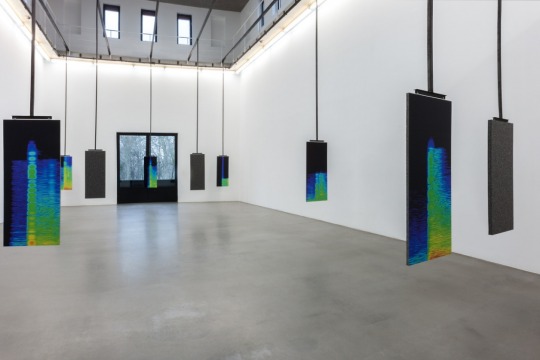
Earshot by Lawrence Abu Hamdan
That is why Evidentiary Realism is now an aesthetic and social tool to analyze the underlying economic, political, legal, and cultural factors that shape society and its shortcomings. To piece together complex puzzle pieces of our reality and create a realistic artistic denouncement to see what is out of sight. The author also refers to its “post-spectacular” characteristics. In fact, Evidentiary Realism with the aestheticization of evidence also aims to synthesize complexity and make it accessible to everyone, evoking emotional responses and instilling knowledge simultaneously.
Technological development allows artists to investigate reality as never before. Evidence is now in so many different forms. And for these forms, even counter forms exist, with for example black boxes being interrogated by counter black boxes and systems to study artificial intelligence. Not only the means of investigations have evolved, but also the forums of presentation and discussions expanded (spaces that lead to the public legitimization of evidence). Nowadays with the immense scope of the internet and social media, the audience has grown immensely and therefore also the needed recognition standard for the evidence.
Enhanced realism in documentary arty refers to “forensic information” which broadly conceptualizes deep media analysis with a different range of techniques and “forensic linguistic” to analyze the media content into investigative discussions. The outcomes of these processes (investigative art and aesthetics) cannot be used in courts as evidence, it is not legally binding. However, it does as classical realism teaches us to raise awareness and act as an agent for change. Moreover, it is defiant in its own existence, questioning the politics of representation with questions on artmaking and its role.
youtube
The aesthetic complements the investigative with juxtapositions, ready-mades, reconstructions, compositions, and mapping that reveal the networks between social issues and the systems. There is no subjectivity in the aesthetics, however. No political slogan or conclusion attached to the author’s opinion has to be deduced by it. The piece should speak and denounce for itself.
Cirio believes it is back now because of enhanced social crises which have arisen in the last decades provoking a widespread interest in the exposure of truth and social challenging of systems. Realism in art has fluctuated and now it is time again for society to take over aesthetics. Uncovering the real is being opposed in an authoritarian fashion in many outlets and with the advent of fake news normalization, there is an urgency for a widespread return to realism.
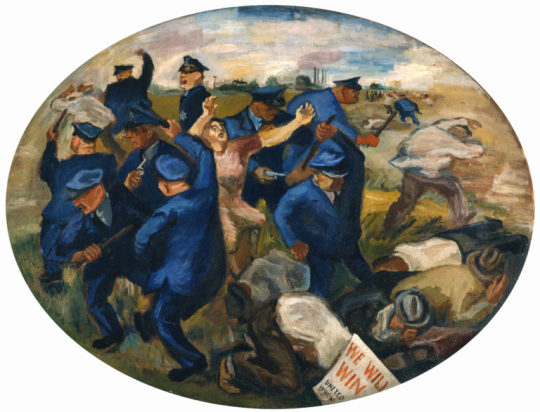
William Gropper, “Little Steel,” ca. 1937, oil on canvas. A piece from the American Social Realism post-war movement
Introduction by Fuller and Weizman
The Introduction of "Investigative Aesthetics" by Fuller and Weizman presents an exploration of the intersection of art, aesthetics, and investigative tactics.
The authors argue that investigative aesthetics provides a valuable framework for understanding and engaging with complex systems of power, as well as a means of generating knowledge and action. Investigative Aesthetics basically consists of the practice of critically collecting and then visually reporting pieces of reports of happenings from media clutter to shape a big picture of a happening. Collaboration between professionals from many professions, as well as people's direct experience of an incident, is vital in the inquiry. The use of aesthetics in investigations can help to create new modes of perception and understanding and can reveal the hidden dimensions of conflicts and human rights abuses. Investigative aesthetics can also help to engage the public in investigations and create a broader understanding of the issues at hand.
Fuller and Weizman begin by discussing the origins of investigative aesthetics, tracing its roots to the practices of art and activism in the 1960s and 1970s. During this period, artists began to experiment with new forms of representation and visual language, often working in collaboration with activists and social movements to address issues such as war, poverty, and social injustice. These artists sought to use art as a means of provoking critical reflection and political action, and their work laid the foundation for the emergence of investigative aesthetics.
The introduction also describes some of Forensic Architecture's investigations, including their investigation into the use of tear gas by Israeli forces in the West Bank and their investigation into the Grenfell Tower fire in London. These investigations demonstrate the agency's approach to using architecture and aesthetics as tools for investigation and how their work reveals the political and social contexts of conflicts and human rights abuses.
Forensic Architecture's investigations are about collecting data and evidence and understanding the power dynamics and political motivations that drive conflicts. By using aesthetics as investigation tools, the agency can reveal the hidden political and social dimensions of conflicts and human rights abuses. It is also acknowledged how Forensic Architecture uses AI to automate the act of seeing. The AI machines have been trained by being “fed” certain datasets and collections of labeled images. Because the “feeders” are human and part of society, the “food” is influenced by their biases, conscious or unconscious.

A still from Forensic Architecture’s video on the explosion in Beirut.
The authors then turn to a broader discussion of the role of aesthetics in investigative work. They argue that aesthetics should be understood as a set of practices and techniques that are used to produce and communicate meaning. In this context, investigative aesthetics refers to the use of these practices and techniques to explore and expose hidden power relations and structures. This can involve a range of different approaches, from visualizing data and creating immersive environments to conducting interviews and engaging in direct action.
The authors also emphasize the importance of collaboration and interdisciplinary approaches in the practice of investigative aesthetics. They note that this field requires a diverse range of skills and perspectives, and that effective investigative work often involves artists, activists, scientists, and other experts working together to achieve common goals. They highlight the key role that technology can play in these collaborations, allowing for the creation of new tools and strategies for investigating complex systems.
The introduction also discusses the broader implications of Forensic Architecture's work. The agency's investigations not only reveal the hidden dimensions of conflicts and human rights abuses but also challenge the dominant narratives and power structures that perpetuate these abuses. By using architecture and aesthetics as tools for investigation, the agency is able to create new modes of perception and understanding that can lead to social and political change.
youtube
An 8-minute video providing a helpful overview of what Forensic Architecture does, narrated by Wiltzman himself.


Two images I have created through a free AI speech-to-image generator. The two prompts were: "Palestinian rally" and "Army of drones flying over a city"
0 notes
Text
MoMA Presents Lawrence Abu Hamdan’s Video Walled Unwalled and His Performances After Sfx, Air Pressure, and Natq in The Kravis Studio
Lawrence Abu Hamdan. Walled Unwalled. 2018. High-definition video (color, sound; 20:04 min.), glass, and painted wood. The Museum of Modern Art, New York. Acquired through the generosity of Elie Kouri. Installation view, The Sound of Screens Imploding, Biennale de l’Image en Mouvement, 2018, Centre d’Art Contemporain Genève, Geneva, Switzerland. © 2022 Lawrence Abu Hamdan, courtesy Centre d’Art…
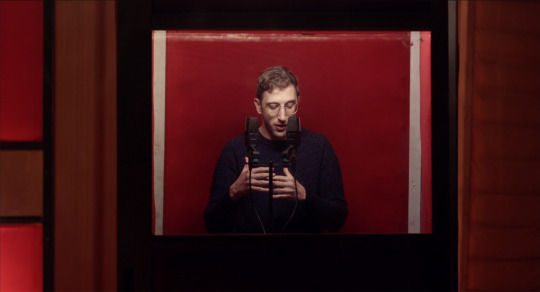
View On WordPress
0 notes
Text
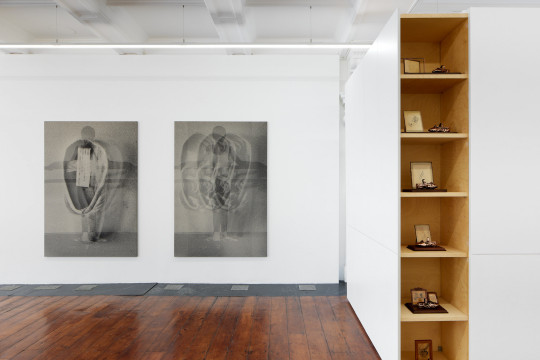

World as diagram, work as dance
Lawrence Abu Hamdan, Emily Barker, Simon Denny, Ana Viktoria Dzinic, Win McCarthy, Gretchen Lawrence, Carolyn Lazard, Coumba Samba, Diamond Stingily
Curated by Tosia Leniarska
03 February – 04 March 2023
Emalin, 1 Holywell Lane, London
1 note
·
View note
Text
Exposición "Todos los caminos no conducen a Roma", Colectiva
Exposición “Todos los caminos no conducen a Roma”, Colectiva
Exposición Todos los caminos no conducen a Roma
Colectiva
13.11.2021
Centro de Arte Contemporáneo Wifredo Lam
14 Bienal de la Habana
“Experiencia 1 Preámbulo que se abrió al público con la exhibición colectiva en el Centro Lam que da título a este texto, integrada por los artistas Dulce Chacón (México), Edith Roux (Francia), Glenda Salazar (Cuba), Lawrence Abu Hamdan (Jordania), MURU 7.8…

View On WordPress
#2021#Centro de Arte Contemporáneo Wifredo Lam#Glenda Salazar#Muestra Colectiva#Nelson Villalobos#Roberto Diago#XIV Bienal de la Habana
0 notes
Text
Abu Hamdan again
In Augustus 2022 I already wrote, here, about my interest in Lawrence Abu Hamdan in whose work art, sound research, language and politics meet.
At the end of November my travels brought me to Besançon and I was happy to see the frac Franche-Comté presented an exhibition Aux frontières de l'audible on Abu Hamdan's work. (19/11/2023 - 14/04/2024) The show contains six works of which 45th Parallel from 2022 and Rubber coated steel from 2016 impressed me most.

Rubber Coated Steel is the video part (21,47 min.) of the installation Earshot. I watched the total video, absorbed by it's aesthetic and narrational force. It was delicate and needed all my attention. This was thorough sound research, which had political impact, brought as a thrilling video piece. Abu Hamdan questions how civil rights are "heard" today. The facts about the rubber bullets disguising real bullets are here.
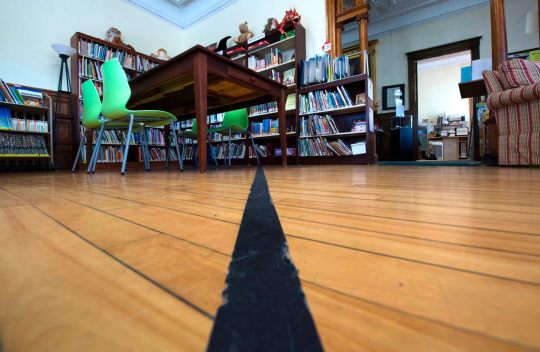
In 45th Parallel, a video (color, sound, 15 min.) and two painted backdrops, the notion of border, often fragile, porous, absurd yet lethal, is narrated as a political and geographical grey zone in the concrete context of the Haskell Free Library and Opera House – a unique municipal site that straddles the jurisdictions of Canada and the United States (see photo of the library). Again, the facts and stories told are impressive, but what touched me especially was how strong and good in Abu Hamdan's work, research and art are entangled. Facts do "speak", but brought this way they "touch" profoundly.
:) Art is a language:)
1 note
·
View note
Photo

LAWRENCE ABU HAMDAN. Air pressure (a diary of the sky)
L’opera di Abu Hamdan offre una riflessione storica e politica sull’impiego del rumore come strumento di espropriazione, condizionamento e controllo.
0 notes
Text
Week 4 Readings
Acoustic Spatiality - Brandon LaBelle
This text has some good insights and views on how spatialisation effects a soundscape. However there’s a lot of academic jargon that gets a bit much. Probably something worth revisiting though…here’s my attempt to pic it apart.
Acoustical Paradigm: “allows for defining more specifically how sound conditions or impacts the material state of things”
“Sound gives to location a force of punctuation, contingency, ephemerality; it envelopes all that we see with an unsteady propagation, as a continual coming forward and receding.”
“It is my interest to reflect upon sound’s particular spatial behavior, and how acoustic spatiality impacts onto understandings of inhabitation and togetherness. I would argue that acoustic spatiality provides conditions of dwelling by figuring bodily, affective and temporal forms of containment and movement. Subsequently, sound lends to an experimental discourse on architecture, place-making and what it means to be together, explicitly introducing an associative mix that promotes radical sociality – a dwelling in difference.”
Movements
“Sound gives to location a force of punctuation, contingency, ephemerality; it envelopes all that we see with an unsteady propagation, as a continual coming forward and receding.”
Sound can punctuate certain elements of an environment e.g. adding sound to the movement of a tree in a 360 video would cause us to focus our attention on it.
“The character of a given sound is radically influenced by its material, acoustical envelope. The particular materiality of a room, for instance, lends dramatically to contouring what we hear, its shape, dynamics, and forcefulness – its voice – through reflection, vibration, ambient tonality.”
The voice of a space plays large factor in determining how we relate to a soundscape.
“From such a perspective, acoustic spatiality is an architecture into which listening moves. It offers a form of dwelling within which particular experiences gain traction, particular routes toward each other unfold, and from which views onto the world are revealed.”
I found this particularly interesting. I like the idea of being an architect of a soundscape. As a sound designer I should think about how a listener might move through the soundscapes I create: Which particular experiences do I want to emphasise? how do i decorate each sonic space?
Ecologies of Strangeness
“ Rather, we can understand acoustic spatiality as zones of intensity, or as timbral identities by which differences are brought into play.”
“As I’ve tried to suggest, an acoustical approach to space enhances an event-architecture precisely by the ways in which sound and sonic events come to life”
“Such a “ghosted” quality must also include a sense for hearing beyond the human or the recognizable – how movements of sound hint at the promise of strangeness.:
By using ‘unnatural’ methods of spatialisation we can imbue a place with strange or otherworldly vibes.
Inhabitation
“Is it possible to think of acoustic spatiality as a place for inhabitation? An actual shelter that provides comfort, or a place for meeting? Might we think of sound as an energetic architecture whose eventness modulates the material edges of the built? To produce form and volume, a time and space for dwelling – to conduct ways of co-existing? Sounds of traffic, the footsteps of passers-by, the turning of pages of a book, all such sonorities appear to open up the material conditions around us, to expand and contract conventional notions of the architectural.”
“Acoustic spatiality opens up and closes down, with each instant of sound creating a dynamic passage across a source and a listener… as a listening subject I am immediately enmeshed within a greater environment of animate forces whose effects elaborate a form of place always already multiple, temporal, and contoured by others.”
Forensic Listeing as Machine Listening: Lawrence Abu Hamdan in conversation with James Parker
An interview about the role of AI, machine learning and audio
“And then what happens is this system starts to become generative of itself. Any speech captured in public space can now be cross-referenced with police tape recordings. Say you’re wiretapped on the phone. The police can then attempt to identify your voice or accent from their archive of recordings. And the two systems feed each other. Now what you’ve got is a system for voice profiling, which in turn starts building its own databases.”
Language texts are no longer being carried out over the phone and instead are now being conducted by automated systems
“That’s when I started investigating this claim by ShotSpotter that 80-95% of gunshots go unreported, and that this is the problem their system could fix. The machine comes in to replace people who don’t call 911. They say in these troubled neighborhoods nobody is calling the police, so we’ll make a system which will automatically call the police. It’s a way of accounting for silence. But it’s not asking why. It’s suggesting that because there’s this silence, it needs to be filled. Instead of listening to what that silence is a consequence of, which is the fact that people distrust the police.”
“Think of cases like Michael Brown’s, where you have a young black man shot and killed by a white police officer (Darren Wilson). The police get called, and they only make the situation worse. With machine listening, we come to the same problem. The machine tries to account for things, but the questions it’s asking are often the wrong ones. They’re almost completely distinct from the questions that need asking on a structural level.”
This is interesting stuff. Reminds me of a project I did in first year about the dangers of AI use in data collection on the internet. AI has no conscience, it can only reference its own data sets when trying to create a picture of reality. If these data sets contain something like racial bias, the AI’s decisions will reflect that.
0 notes

